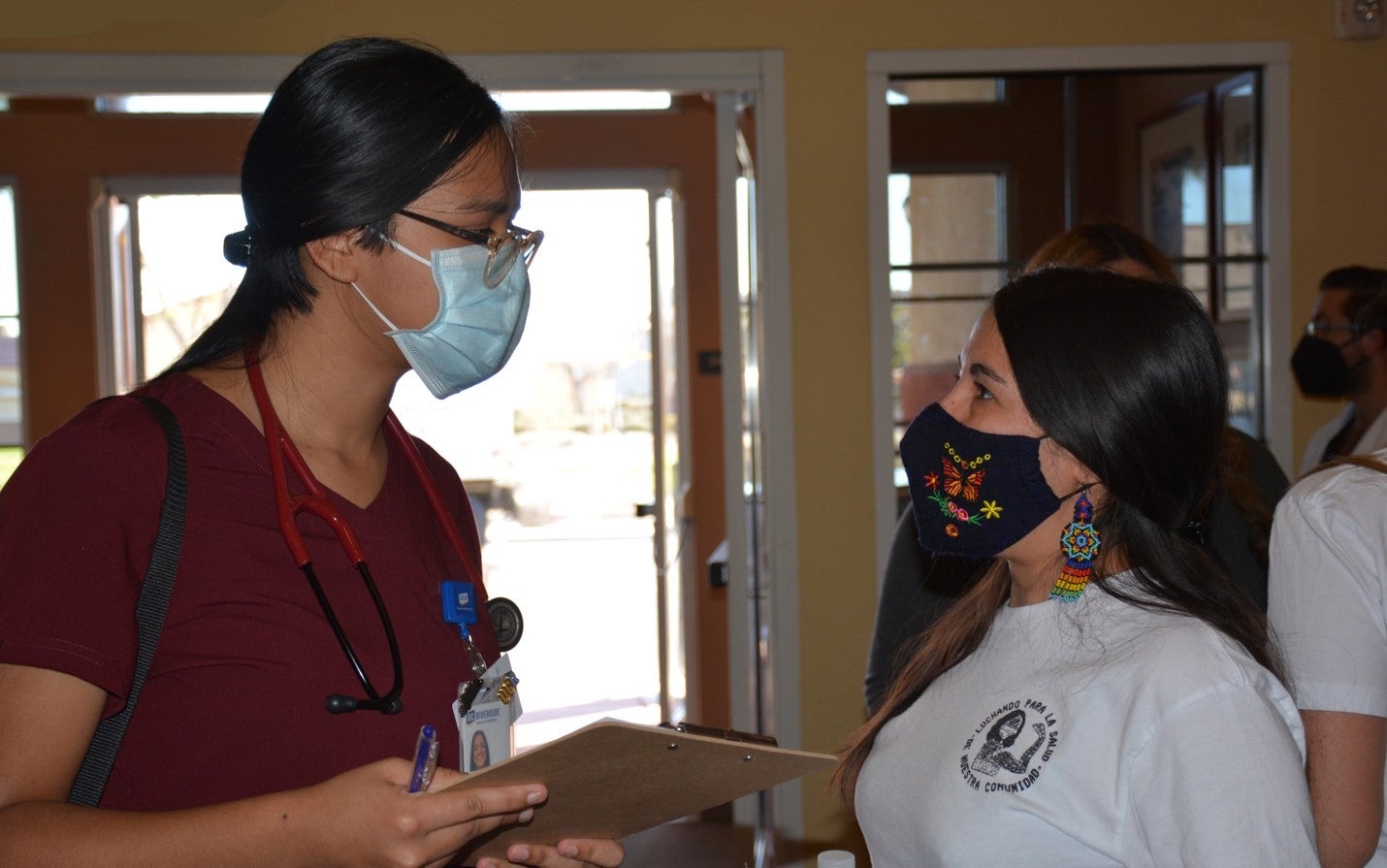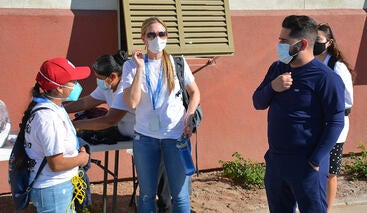
Medical Spanish Designated Emphasis (HABLAMOS)
Designated Emphasis in Medical Spanish (HABLAMoS)
The Designated Emphasis (DE) in Medical Spanish is a four-year language learning program that includes classroom instruction and experiential learning opportunities in Spanish-speaking clinics, engagement with community health workers (promotoras), and families in rural and urban communities in Inland Southern California as well as Spanish-speaking communities in Latin America. The DE follows HABLAMoS (Hispanic and Bilingual Longitudinal Ambulatory Medical Studies) curriculum.
The DE in Medical Spanish provides medical students with skills to communicate with Spanish-speaking patients and families in clinic, community, and public health settings, as well as a foundation to understand how culture and structure influence patient health and well-being and clinical interactions. The program considers medical students' baseline Spanish language skills, sets personalized goals to improve Spanish language acquisition (e.g., oral communication, public speaking, written language skills) in medical and public health contexts, and deepens understanding of culture and structural inequity in health among Spanish-speaking patients.
To learn more about our activities, successes, and public health impacts, read our Executive Report and Research Report.
Contact Ann Cheney, Ph.D. for more information
About the Program
Students of all language levels can join the program during their first year of medical school and up until the end of block 1 of their second year. Students must complete a minimum of 200 hours of Spanish-language learning spread out across the four years of the medical school curriculum to receive the DE in Medical Spanish.
Year 1 Program Goals
Year one builds the foundation for Spanish-language learning in medical contexts. Students receive one unit of selective credit for Medical Spanish on their transcript by completing 14-of-18 available activity hours for the Medical Spanish selective. Students are expected to:
- Participate in conversational lunch workshops.
- Attend Medical Spanish classes.
- Practice effective communication in patient-provider interactions through modules and OSCEs.
- Apply language skills to clinical encounters with Spanish-speaking patients during attendance at student-led free clinics.


Year 2 Program Goals
Year two strengthens students’ language skills and emphasizes oral communication in clinical encounters with Spanish-speaking patients and families.
Medical students attend case-based learning modules taught by Spanish-speaking physicians, as well as participate in cross-cultural conversations with native Spanish-speaking students from Mexico. Interested students work with program leadership to incorporate Spanish into scholarly activities.
Year 3 Program Goals
Year three deepens students’ Medical Spanish vocabulary, cross-cultural education, and cultural humility in the context of caring for Spanish-speaking patients.
Medical students work independently on their written and oral language skills through online language learning models via CanopyLearn, recipient of the National Institutes of Health (NIH) innovation award.
Year 4 Program Goals
Year four immerses students in Spanish-speaking clinics and families in Southern California and provides experiential learning into the cultural and structural factors that shape the health of Latino patients, patient-provider dynamics, and patient experiences in clinical spaces.
- Students participate in either a four-week clinical rotation in a clinic serving a primarily Spanish-speaking patient population or scholarly activity focused on Latinx immigrant health.
- Students participating in the clinical rotation spend 30 hours in the clinic, participate in virtual classes, and can opt into a homestay with a Spanish-speaking family.
- Students participating in the scholarly activity engage in independent work involving readings and reflection, as well as Medical Spanish classes, virtual seminars and conversations with community members.
- All instruction is in Spanish and includes community engagement and a virtual public health talk at the close of the rotation or scholarly activity.
Program Leadership
- Ann Cheney, PhD, director and founder of HABLAMoS curriculum
- Evelyn Vázquez, PhD, MS, assistant director
- Nuria Rico, MD, professor of medical Spanish
- Jacqueline Moreira, DE coordinator
Our Podcasts
Lección 1
A1
En este podcast, “Yo Soy,” se revisan las presentaciones básicas para expresar nombre, país o nacionalidad así como ocupación y profesión. En gramática se trabaja con el verbo SER en presente de indicativo.
A2
En este podcast, “Me duele la cabeza” se revisan algunas expresiones para malestares físico o sensaciones físicas y recomendaciones para el Alivio de dichos malestares. Descarga la actividad aquí.
B1
En este podcast, “Una mañana- parte 1,” se revisan los elementos gramaticales y estructurales para contar una anécdota. Se revisa el pretérito y el imperfecto de indicativo así como organizadores de anécdotas. En “la parte 2 y anexo sobre la diabetes” se revisa el vocabulario relacionado con el tema. Descarga la actividad aquí.
Lección 2
A1-A2
En este podcast llamado “El virus”, se revisan información relacionada con la pandemia actual. Así mismo con estructuras en presente como “Tener que, haber que y deber”, para que el proveedor de salud proporcione información de las medidas que se deben llevar a cabo para evitar contagios.
A2-B1
En este podcast llamado “enfrentar al virus”, se revisan información relacionada con la pandemia actual. Así mismo con estructuras en presente como “Tener que, haber que y deber”, para que el proveedor de salud proporcione información de las medidas que se deben llevar a cabo para evitar contagios. Finalmente se revisarán expresiones con el imperativo para dar instrucciones.
B2-C1
En este podcast llamado “enfrentando al virus”, se revisan información relacionada con la pandemia actual. Así mismo con estructuras en presente como “Tener que, haber que y deber”, para que el proveedor de salud proporcione información de las medidas que se deben llevar a cabo para evitar contagios. Finalmente se revisarán expresiones con el imperativo para dar instrucciones.
Lección 3
A1-A2
Este podcast llamado "obesidad infantil" revisa información relacionada con cómo tratar la obesidad infantil, por ejemplo, como proponer soluciones y recomendaciones para padres e hijos con respecto a los alimentos. En gramática, las estructuras impersonales se aprenderán con el verbo BE y el infinitivo. Asimismo, se revisa el imperativo.
A2-B1
Este podcast llamado "Contra la obesidad infantil" revisa información relacionada con como tratar la obesidad infantil, por ejemplo, como proponer soluciones y recomendaciones para padres e hijos con respecto a los alimentos. En gramática, las estructuras impersonales se aprender con el verbo SER y el tiempo presente del subjuntivo y el imperativo.
B2-C1
Este podcast llamado "Contra los problemas de la obesidad infantil" revisa información relacionada con cómo tratar la obesidad infantil, por ejemplo, como proponer soluciones y recomendaciones para padres e hijos con respecto a los alimentos.
